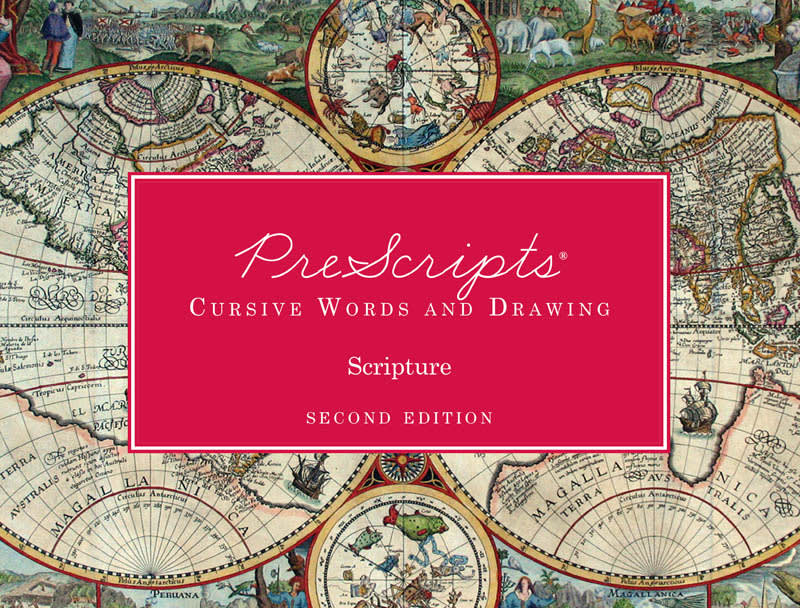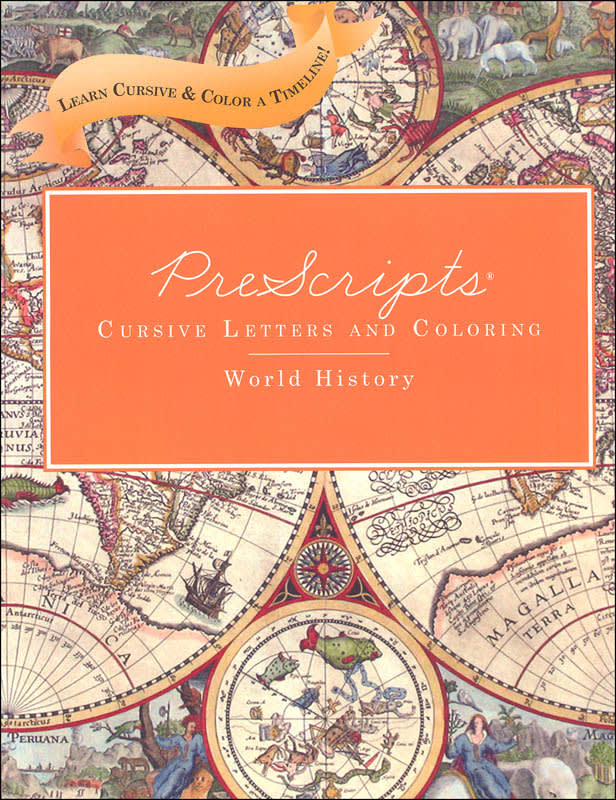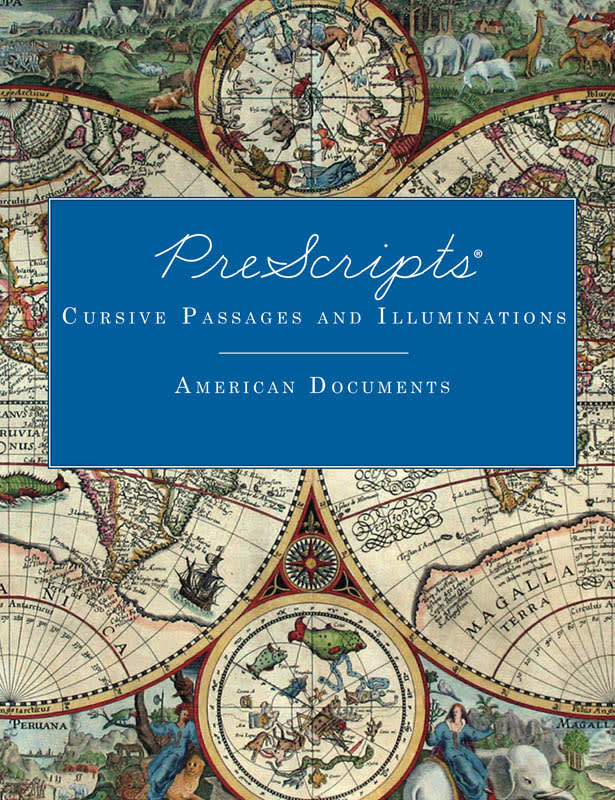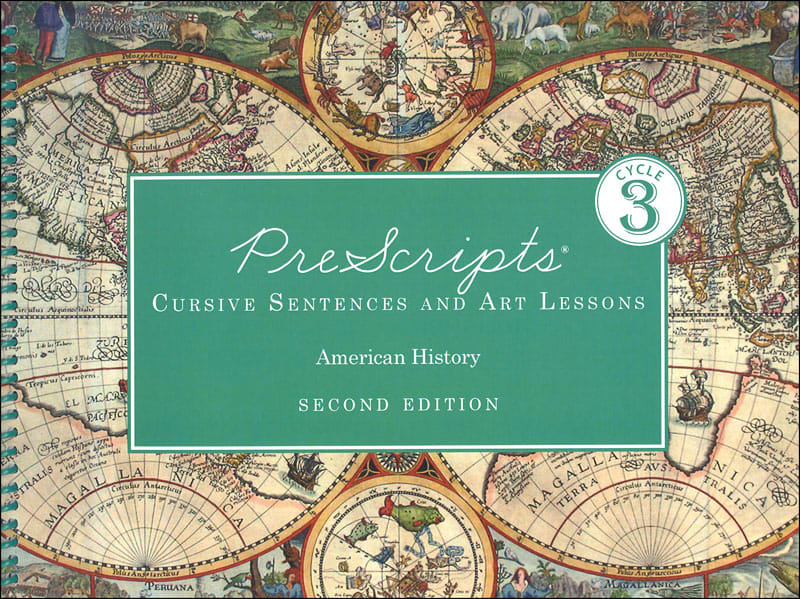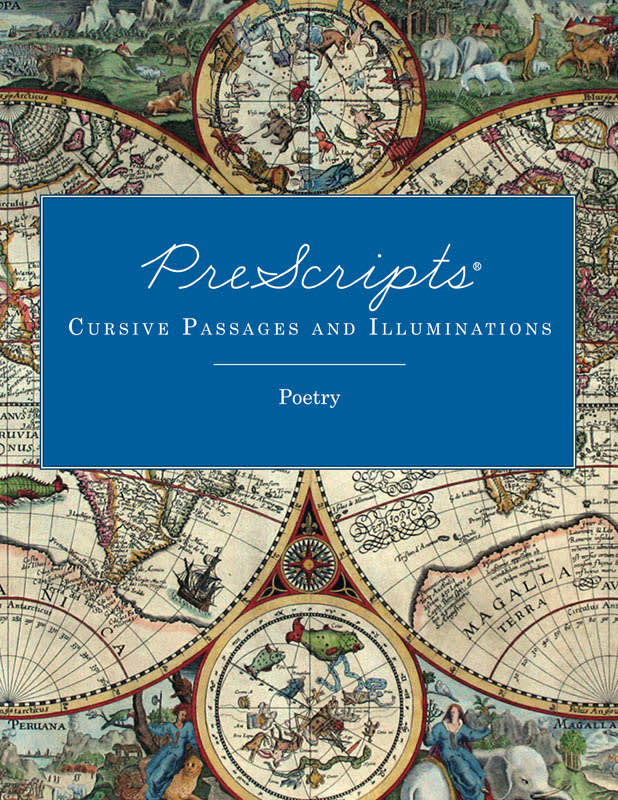Classical Conversations has published a cursive program that incorporates art lessons and activities along with meaningful content that connects to other subject areas. While there are other handwriting programs and copywork books that have students practice handwriting with meaningful material, the Prescripts series is distinctive because it offers cursive instruction that might begin in preschool and because it incorporates art lessons that reinforce the development of small motor skills.
In support of Classical Conversations’ philosophy of education, the PreScripts series has students practice handwriting by copying words written by others before writing their own compositions. The material that students copy is important in itself. Rather than fluff, students copy Scripture, historical statements, and other worthwhile material.
Nine courses are available at this time. The lowest levels might be used at whatever point you want to teach cursive, even at the preschool level according to the publisher. (Classical Conversations encourages teaching cursive rather than manuscript for beginning handwriting.) Courses are not designated for certain grades, but there is a progression in difficulty for some of the courses that should influence your choice. The cursive style is Zaner-Bloser®, a popular simplified-cursive style that omits initial loops.
All of the course books have a spiral binding. However, six of the books are laid out in landscape mode with the binding at the top while three are in portrait mode with the binding on the left. Printing is on both sides of pages in all books, although the “landscape” books print the back of the pages in the same direction as the fronts so students need not reverse the book as the flip pages. However, as students turn the pages in the first four books, the binding alternates from being at the top to the bottom, so the binding might be in the way at some points. With the books laid out in portrait mode, the binding alternates from left side to right and might pose a similar problem. You might choose to remove pages from the book if this is a problem.
Learning Letters
PreScripts Cursive Letters and Coloring: World History and PreScripts Cursive Letters and Coloring: Medieval to Modern World History are both for ages three through seven. I think it most likely that you would begin one of these courses at the kindergarten level unless your child has extremely good small motor coordination. Both courses teach all of the letters of the alphabet, both upper and lower cases. Students write only individual letters working through the alphabet in order, learning uppercase letters first and lowercase letters second. Initial instruction is done on a very large line with arrows and numbers showing how to form each letter. Practice lines are smaller—one inch in height. Students first trace with crayon or pencil, then practice forming their own letters. The first few lessons have students practice trace circles, ovals, straight lines, angles, and squiggles to help develop pencil control. Each lesson also includes a coloring or drawing page. Coloring pages are mostly simplified blackline drawings based on some of the illustrations on Classical Conversations’ Classical Acts & Facts History Cards. Some lessons have trace-and-color activities where children learn to draw simple shapes such as a boat, a flower, a worm, or a bird. (Some of these art lessons show up in the identical form in other books.)
Learning Words and Sentences
PreScripts Cursive Words and Drawing: Scripture, recommended for ages five through ten, quickly reviews upper and lower case forms for all of the letters in an introductory lesson. Part I continues with lessons that each begin with a letter of the alphabet, then a word, then a Bible verse that uses that word. Bible verses are from the NKJV. In each case, students first trace letters or words, then write them on their own. In Part II students learn to write number words in cursive, and lessons in Part III focus on tricky letter combinations found in the first chapter of the book of James.
Art activities accompany every lesson in Part I and every two or three lessons in the last two sections. Art lessons begin with simple circles, lines, curves, shapes, and squiggles. Then students trace and draw simple forms of a flower, a worm, a boat, and other objects. Students learn to draw repeating elements in grids as well as symmetrical objects. Toward the end, drawing techniques such as foreshortened circles, drawing three-dimensional objects, shading, and drawing cubes are introduced—still at a simple level. A number of pages are allotted to “free drawing.”
Prescripts Cursive Words and Drawing: Math Terms is similar to PreScripts Cursive Words and Drawing: Scripture, but the content relates to math. Students might copy and practice writing mathematical terms and definitions while drawing exercises teach patterns, symmetry, and basic geometric forms. This course might be used alongside any math program and across a wide span of grade levels. While the publisher considers it the same level as PreScripts Cursive Words and Drawing: Scripture (i.e., for ages five through ten), I would probably recommend it for at least second grade and above simply because students will not be encountering all of the mathematical terms before then and maybe, even then, not for a few years.
History-Based Lessons
PreScripts Cursive Sentences and Art Lessons: Ancient History, PreScripts Cursive Sentences and Art Lessons: Medieval to Modern History, and PreScripts Cursive Sentences and Art Lessons: American History once again connect with the Classical Acts & Facts History Cards, but this time aimed at students ages seven through twelve. Most of the illustrations represent “memory peg images” from the Classical Conversations history cards. The statements, likewise, connect to those cards. The books are arranged in four sections, and each section has six historical fact statements to be traced and then written.
While the Prescripts Cursive Letters and Coloring course has students color pictures, these courses have students copy the drawings and learn about principles such as point of view, proportion, and symmetry. The Medieval to Modern History book also teaches the use of rough geometric shapes to approximate the human body in different positions as well as drawing shadows, blending, and a few other techniques. However, art instruction is relatively brief and sporadic since cursive practice and review of historical events are the primary goals of the courses.
Copying Passages
Prescripts Cursive Passages and Illuminations: American Documents is for students in about fourth grade through high school. Content is drawn from Classical Conversations’ Words Aptly Spoken: American Documents, a collection of documents and excerpts from documents. Excerpts used in Passages and Illuminations are drawn from sources such as The Mayflower Compact, The U.S. Constitution, The Monroe Doctrine, and Henry Cabot Lodge’s “League of Nations Speech.”
“Illuminations” in the course title refers to the illuminated letters that students practice either copying or creating.
While students might trace the written passages directly in the book, most students tackling this course are likely to be beyond that point. They can copy passages onto the lines directly beneath each line of the passage, and they can draw illuminated letters in the space provided in the book. However, you might find it more worthwhile to have students copy the passages onto lined paper. If you want to reuse the book, students can also draw the illuminated letters on drawing paper. Most of the written passages are longer than those in other courses. In addition, the content is definitely more appropriate for older students because of the vocabulary and sentence structure. One example from The Federalist: Number 30 reads, “How is it possible that a government half supplied and always necessitous, can fulfill the purposes of its institution, can provide for the security, advance the prosperity, or support the reputation of the commonwealth? How can it ever possess either energy or stability, dignity or credit, confidence at home or respectability abroad?”
There are 67 lessons in the book, so you might cover about two per week to complete the book in one year. Alternatively, you might use one per week and use the book over two years.
Prescripts Cursive Passages and Illuminations: Poetry targets the same grade levels with content based on poems. Students copy poems while learning about rhetorical devices used in poetry such as similes and metonymy (referring to a thing by the name of something closely associated with it). Students also learn to illustrate the imagery described in the poems.
Summary
The PreScripts cursive program has brief instructions in each book, but it does not provide extensive information on teaching handwriting such as posture, alignment of the page, how to hold the pencil, and how to join cursive letters into words. The focus instead is on copying models--learning the forms of the letters and joins by tracing and copying. The inclusion of worthwhile written passages and the reinforcement of art lessons make it a worthy contender in an arena crowded with many other handwriting programs.










